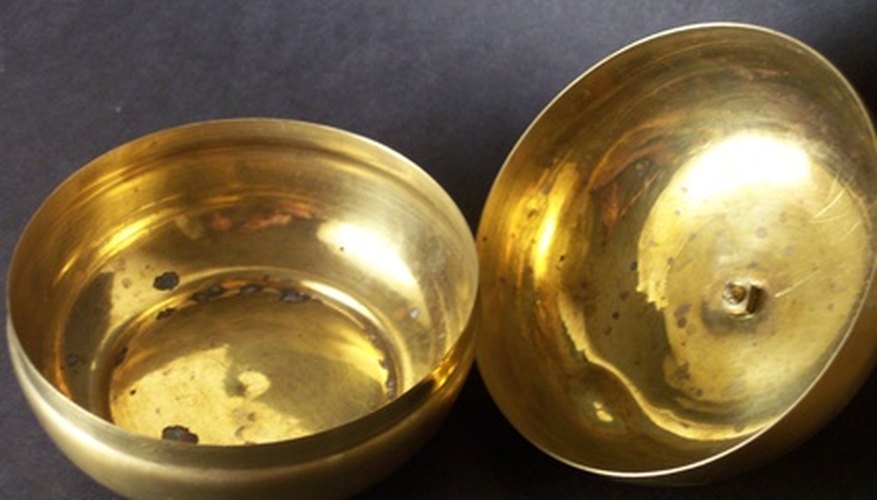Volume and depth are two measurements that describe the attributes of a 3-D space. Volume describes the amount of material that may be contained in a space while the depth, or height, describes the distance between the two primary planes. When calculating the volume and depth of a bowl, you should use the formulas for a shape that matches that of the bowl in question. If the bowl has a rounded bottom with no flat base, use the formula for a spherical cap. Otherwise, use the formulas for sphere segments.
- Volume and depth are two measurements that describe the attributes of a 3-D space.
- When calculating the volume and depth of a bowl, you should use the formulas for a shape that matches that of the bowl in question.
Measure the distance from one lip of the bowl to the opposite side using the interior of the lip to obtain the measurement; divide by 2 to obtain the radius. For example, if the bowl's diameter equals 6 inches, its radius equals 3 inches. Lay the straightedge across the mouth of the bowl. Lower the ruler into the centre of the bowl. Write down the number marked by the lower edge of the straight edge; this is the depth. For this example, the depth is 4 inches.
- Label the solution as cubic units, where units is equivalent to the unit of height and radius.
- Lower the ruler into the centre of the bowl.
Insert the radius and height into the following formula: volume = (pi/6) * (3* radius squared + height squared) * height. Plugging in the numbers from Step 1, you get: volume = (pi/6) * (3 * 3 squared + 4 squared) * 4.
Solve for volume. Begin by calculating the figures within each parenthetical phrase, then multiply the figures on the right side of the equation. Round figures to the hundredths place. For example, divide pi by 6. Calculate the square of 3 and 4. The formula will now read as follows: volume = (.52) * (3 * 9 + 12) * 4. Multiply 3 times 9. Add 27 and 12. The formula is now: volume = .52 * 39 * 4. Multiply the three figures to obtain the total 81.68.
Label the solution as cubic units, where units is equivalent to the unit of depth and radius. For example, 81.68 cubic inches.
Measure the distance from one lip of the bowl to the opposite side using the interior of the lip to obtain the measurement; divide by 2 to obtain the radius. For example, the diameter equals 6 inches, so the radius of this base is 3 inches. Measure the diameter of the interior circle of the bowl using a tape measure; divide the figure by 2 to obtain the radius. For example, the diameter is 5 inches, so the radius of the second base is 2.5 inches. Lay the straightedge across the mouth of the bowl. Lower the ruler into the centre of the bowl. Write down the number marked by the lower edge of the straightedge; this is the depth. For example, the depth is 4 inches.
- Label the solution as cubic units, where units is equivalent to the unit of height and radius.
- Lower the ruler into the centre of the bowl.
- Label the solution as cubic units, where units is equivalent to the unit of depth and radius.
- For example, the diameter equals 6 inches, so the radius of this base is 3 inches.
Insert the radii and height into the following formula: volume = (pi/6) * [(3 * radius of the top base squared) + (3 * radius of the lower base squared) + (height squared)] * height. For example, volume = (pi/6) * [(3 * 3 squared) + (3 * 2.5 squared) + (4 squared)] * 4.
Solve for volume. For example, divide pi by 6 to obtain .52. Calculate the squares of 3, 2.5 and 4. Insert the values into the formula: volume = (.52) * [(3 * 9) + (3 * 6.25) + (16)] * 4. Multiply the figures in the parentheses. The formula will now read: volume = (.52) * [(27) + (18.75) + (16)] * 4. Add the three figures in the brackets: volume = (.52) * (61.75) * 4. Multiply the remaining figures to reach the volume. The solution is 128.44.
Label the solution as cubic units, where units is equivalent to the unit of height and radius. For example, 128.44 cubic inches. This bowl holds more than the spherical cap of the same height because it has a wider base. The sphere segment is closer to being cylindrical.
Measure the depth. Lay the straightedge across the mouth of the bowl. Lower the ruler into the centre of the bowl. Write down the number marked by the lower edge of the straightedge; this is the depth. For example, the depth is 4 inches.
- Label the solution as cubic units, where units is equivalent to the unit of height and radius.
- Lower the ruler into the centre of the bowl.
Obtain the surface area and radius of the sphere. For example, the radius of the sphere is 10 and the surface area is 1256.6 square inches.
Insert the figures into the following formula: surface area of sphere = 2 * pi * radius * depth. For example, 1256.6 = 2 * pi * 10 * depth.
Solve for depth. For example, multiply 2 times pi times 10. Write the product, 62.83, in the formula as follows: 1256.6 = 62.83 * depth. Divide both sides of the equation by 62.83. The depth equals 20.
Label the solution with the unit of the radius. For example, 10 inches.
